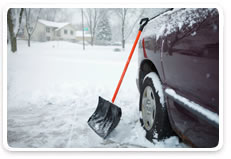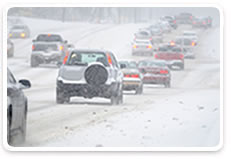Prepare your vehicle for winter weather well before winter begins. Preventive maintenance helps to ensure that avoidable problems do not occur, especially during inopportune times such as severe weather. Before driving in questionable weather, check the following on your vehicle: battery, lights, belts, brakes, windshield wipers, defroster, heater and exhaust system.
Ensure your tires have adequate tread and air pressure. All-weather radials are usually adequate for most winter conditions. However, some jurisdictions require vehicles to be equipped with chains or snow tires with studs. Check the air pressure frequently to maintain the manufacturer’s recommended pressure.
Maintain at least a half tank of gas during the winter season. This ensures you have a source of heat if you are stuck or stranded. It also keeps water from condensing and building up in your gas tank, which can eventually rusts out the tank.
Clear snow and ice off your entire vehicle: windshield, windows, outside mirrors, lights, reflectors, hood, roof and trunk. Visibility is essential when road conditions are at their worst. You will need all the windows clear in order to fully predict the road conditions and actions of other drivers. Clear lights and reflectors also allow other drivers to see you better. Furthermore, brushing off the entire vehicle prevents snow from flying off and blocking your view or that of drivers around you.
Make sure your vehicle is equipped with good wiper blades and that they exert enough pressure to ensure a clean sweep. Keep the windshield washer reservoir full and extra fluid in your trunk. The reservoir can empty quickly on snowy or messy days.
Get the feel of the road. Occasionally test your brakes or gently depress your accelerator while driving. Once you know how slippery the road is, adjust your speed accordingly.
Today most cars and light trucks are equipped with anti-lock brakes. For anti-lock brakes to work correctly, or at all, during an emergency stop, apply firm and steady pressure. If the vehicle is not equipped with anti-lock brakes, then pumping the brakes is the proper way to keep the vehicle in control when stopping on a slippery road. Pumping the brakes is applying the brakes up to the point, but not quite, of stopping the wheels from rotating, then letting up. Applying too much brake can lock the wheels causing the vehicle to slide out of control.
Always drive with your headlights on to increase your ability to see and other’s ability to see you. Be sure to keep them clean. Dirty headlights can greatly reduce your visibility, especially at night.
Inform others of your destination and expected time of arrival. Leave yourself plenty of time to clean off your vehicle, drive safely and still arrive on time.
 Keep some basic essentials in your vehicle during the winter months. Having a snowbrush, ice scraper, shovel, sand, and windshield washer fluid in your vehicle will ensure you can see while driving and may help you in some difficult situations. Putting extra food, water, blankets and extra clothes in your vehicle also can be helpful – and even save your life – in case of long delays.
Keep some basic essentials in your vehicle during the winter months. Having a snowbrush, ice scraper, shovel, sand, and windshield washer fluid in your vehicle will ensure you can see while driving and may help you in some difficult situations. Putting extra food, water, blankets and extra clothes in your vehicle also can be helpful – and even save your life – in case of long delays.
Keep in mind that speed limits are meant for dry roads, not roads covered in snow and ice. Adjust your speed and increase your following distance as road conditions and visibility get worse. It may be necessary to triple or quadruple the Two-Second Rule. Bridges and overpasses are the first areas to become icy. Avoid sudden stops and quick direction changes. Don’t tailgate.
Never use your cruise control in snowy or icy conditions. Cruise control may cause your vehicle to accelerate at inopportune moments. Additionally, roads that appear clear can have slippery spots and the short touch of your brakes to deactivate the cruise control feature can cause you to lose control of your vehicle.
Four-wheel drive vehicles may help you get going quicker than other vehicles, but they will not help you stop any faster. Many four-wheel drives are heavier than passenger vehicles and actually may take longer to stop. A four-wheel drive also can lose traction just as quickly as a two-wheel drive vehicle.
Most importantly, if conditions become severe, find a safe place to park until driving conditions improve.
https://www.travelers.com/resources/auto/safe-driving/winter-driving-safety-tips.aspx



